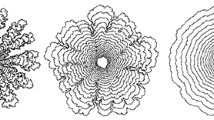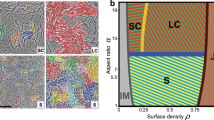Abstract
In this paper we present continuous age- and space-structured models and numerical computations of Proteus mirabilis swarm-colony development. We base the mathematical representation of the cell-cycle dynamics of Proteus mirabilis on those developed by Esipov and Shapiro, which are the best understood aspects of the system, and we make minimum assumptions about less-understood mechanisms, such as precise forms of the spatial diffusion. The models in this paper have explicit age-structure and, when solved numerically, display both the temporal and spatial regularity seen in experiments, whereas the Esipov and Shapiro model, when solved accurately, shows only the temporal regularity.
The composite hyperbolic-parabolic partial differential equations used to model Proteus mirabilis swarm-colony development are relevant to other biological systems where the spatial dynamics depend on local physiological structure. We use computational methods designed for such systems, with known convergence properties, to obtain the numerical results presented in this paper.
Similar content being viewed by others
References
Aronson, D.G.: The role of diffusion in mathematical population biology: Skellam revisited. In: Mathematics in Biology and Medicine, V. Capasso, E. Grosso, S.L. Paveri-Fontana, (eds.), vol. 57 of Lecture Notes in Biomathematics, Springer-Verlag, Berlin, 1985, pp. 2–6
Ayati, B.P.: A variable time step method for an age-dependent population model with nonlinear diffusion. SIAM J. Numer. Anal. 37, 1571–1589 (2000)
Ayati, B.P., Dupont, T.F.: Galerkin methods in age and space for a population model with nonlinear diffusion. SIAM J. Numer. Anal. 40, 1064–1076 (2002)
Ayati, B.P., Dupont, T.F.: Convergence of a step-doubling Galerkin method for parabolic problems. Math. Comp. 74, 1053–1065 (2005) Article electronically published on September 10, 2004
Bellomo, N., Preziosi, L.: Modelling and mathematical problems related to tumor evolution and its interaction with the immune system. Math. Comput. Model. 32, 413–452 (2000)
Bertuzzi, A., Gandolfi, A.: Cell kinetics in a tumor cord. J. Theor. Biol. 204, 587–599 (2000)
Bolker, B.M., Pacala, S.W., Neuhauser, C.: Spatial dynamics in model plant communities: What do we really know? American Naturalist 162, 135–148 (2003)
Busenberg, S., Iannelli, M.: A class of nonlinear diffusion problems in age-dependent population dynamics. Nonlin. Anal. Th. Meth. Appl. 7, 501–529 (1983)
Chiu, C.: A numerical method for nonlinear age dependent population models. Diff. Int. Eqns. 3, 767–782 (1990)
de Roos, A.M.: Numerical methods for structured population models: The escalator boxcar train. Num. Meth. Part. Diff. Eqns. 4, 173–195 (1989)
de Roos, A.M.: A gentle introduction to physiologically structured population models. In: Structured-population Models in Marine, Terrestrial, and Freshwater Systems, S. Tuljapurkar, H. Caswell, (eds.), vol. 18 of Population and Community Biology Series, Chapman & Hall, New York, 1997, ch. 5, pp. 119–204
de Roos, A.M., Metz, J.A.J.: Towards a numerical analysis of the escalator boxcar train. In: Differential Equations with Applications in Biology, Physics and Engineering, J.A. Goldstein, F. Kappel, W. Schappacher, (eds.), vol. 133 of Lecture Notes in Pure and Applied Mathematics, Marcel Dekker, New York, 1991, pp. 91–113
di Blasio, G.: Non-linear age-dependent population diffusion. J. Math. Bio. 8, 265–284 (1979)
di Blasio, G., Lamberti, L.: An initial-boundary problem for age-dependent population diffusion. SIAM J. Appl. Math. 35, 593–615 (1978)
Dyson, J., Villella-Bressan, R., Webb, G.F.: Asynchronous exponential growth in an age structured population of proliferating and quiescent cells. Math. Biosci. 177–178, 73–83 (2002)
Esipov, S.E., Shapiro, J.A.: Kinetic model of proteus mirabilis swarm colony development. J. Math. Biol. 36, 249–268 (1998)
Fairweather, G., López-Marcos, J.C.: A box method for a nonlinear equation of population dynamics. IMA J. Numer. Anal. 11, 525–538 (1991)
Gear, C.W.: Numerical Initial Value Problems in Ordinary Differential Equations. Prentice–Hall, New Jersey, 1971
Gurtin, M.E.: A system of equations for age-dependent population diffusion. J. Theor. Biol. 40, 389–392 (1973)
Gurtin, M.E., MacCamy, R.C.: Non-linear age-dependent population dynamics. Arch. Rat. Mech. Anal. 54, 281–300 (1974)
Gurtin, M.E., MacCamy, R.C.: Diffusion models for age-structured populations. Math. Biosci. 54, 49–59 (1981)
Höfer, T., Sherratt, J.A., Maini, P.K.: Cellular pattern formation during Dictostelium aggregation. Physica D 85, 425–444 (1995)
Huang, C.: An age-dependent population model with nonlinear diffusion in ℝn. Quart. Appl. Math. 52, 377–398 (1994)
Ionides, E.L., Fang, K.S., Isseroff, R.R., Oster, G.F.: Stochastic models for cell motion and taxis. J. Math. Biol. 48, 23–37 (2004)
Kim, M.-Y.: Galerkin methods for a model of population dynamics with nonlinear diffusion. Num. Meth. Part. Diff. Eqns. 12, 59–73 (1996)
Kim, M.-Y., Park, E.-J.: Mixed approximation of a population diffusion equation. Computers Math. Applic. 30, 23–33 (1995)
Kohyama, T.: Size-structured multi-species model of rain forest trees. Functional Ecology 6, 206–212 (1992)
Kohyama, T.: Size-structured tree populations in gap-dynamic forest – the forest architecture hypothesis for the stable coexistence of species. J. Ecology 81, 131–143 (1993)
Kooi, B.W. Kooijman, S.A.L.M.: Discrete event versus continuous approach to reproduction in structured population dynamics. Theor. Popul. Biol. 56, 91–105 (1999)
Kraemer, M.A., Kalachev, L.V., Coble, D.W.: A class of models describing age structure dynamics in a natural forest. Natural Resource Modeling 15, 149–200 (2002)
Kubo, K., Langlais, M.: Periodic solutions for a population dynamics problem with age-dependence and spatial structure. J. Math. Biol. 29, 363–378 (1991)
Kwon, Y., Cho, C.-K.: Second-order accurate difference methods for a one-sex model of population dynamics. SIAM J. Numer. Anal. 30, 1385–1399 (1993)
Langlais, M.: A nonlinear problem in age-dependent population diffusion. SIAM J. Math. Anal. 16, 510–529 (1985)
Langlais, M.: Large time behavior in a nonlinear age-dependent population dynamics problem with spatial diffusion. J. Math. Biol. 26, 319–346 (1988)
Lopez, L., Trigiante, D.: A finite difference scheme for a stiff problem arising in the numerical solution of a population dynamic model with spatial diffusion. Nonlin. Anal. Th. Meth. Appl. 9, 1–12 (1985)
López-Marcos, J.C.: An upwind scheme for a nonlinear hyperbolic integro-differential equation with integral boundary condition. Computers Math. Applic. 22, 15–28 (1991)
MacCamy, R.C.: A population model with nonlinear diffusion. J. Diff. Eqns. 39, 52–72 (1981)
Marcati, P.: Asymptotic behavior in age-dependent population dynamics with hereditary renewal law. SIAM J. Math. Anal. 12, 904–916 (1981)
Medvedev, G.S., Kaper, T.J., Kopell, N.: A reaction-diffusion equation with periodic front dynamics. SIAM J. Appl. Math. 60, 1601–1638 (2000)
Murray, J.D.: Mathematical Biology II: Spatial Models and Biomedical Applications, vol. 18 of Interdisciplinary Applied Mathematics, Springer–Verlag, Berlin, third ed., 2003
Nagylaki, T.: The diffusion model for migration and selection. In: Some Mathematical Questions in Biology: Models in Population Biology, A. Hastings, (ed.), vol. 20 of Lectures on Mathematics in the Life Sciences, American Mathematical Society, Providence, R.I., 1989, pp. 55–75
Pascual, M., Levin, S.A.: Spatial scaling in a benthic population model with density-dependent disturbance. Theor. Popul. Biol. 56, 106–122 (1999)
Preziosi, L. ed.: Cancer Modelling and Simulation. Chapman & Hall/CRC, 2003
Rauprich, O., Matsushita, M., Weijer, K., Siegert, F., Esipov, S.E., Shapiro, J.A.: Periodic phenomena in Proteus mirabilis swarm colony development. J. Bacteriol. 178, 6525–6538 (1996)
Rotenberg, M.: Theory of population transport. J. Theor. Biol. 37, 291–305 (1972)
Skellam, J.G.: Random dispersal in theoretical populations. Biometrika 38, 196–218 (1951)
Sulsky, D.: Numerical solution of structured population models, I. age structure. J. Math. Biol. 31, 817–839 (1993)
Webb, G.F.: Theory of Nonlinear Age–dependent Population Dynamics. vol. 89 of Pure and Applied Mathematics, Marcel Dekker, New York, 1985
Williams, F.D., Schwarzhoff, R.H.: Nature of the swarming phenomenon in Proteus. Ann. Rev. Microbiol. 32, 101–122 (1978)
Author information
Authors and Affiliations
Corresponding author
Rights and permissions
About this article
Cite this article
Ayati, B. A structured-population model of Proteus mirabilis swarm-colony development. J. Math. Biol. 52, 93–114 (2006). https://doi.org/10.1007/s00285-005-0345-3
Received:
Revised:
Published:
Issue Date:
DOI: https://doi.org/10.1007/s00285-005-0345-3




